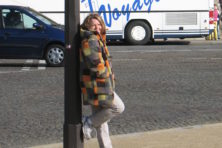Moving History: David DeVooght relocates Little Sister Resort
- Share
- Tweet
- Pin
- Share

The first dim light of morning is only beginning to stretch over the Sister Bay water tower March 8, but David DeVooght and his 18-person crew have already been on-site for an hour, preparing the first of four buildings they would move that day.
Workers from Wisconsin Public Service are beginning the task of disconnecting power lines along the edge of Highway 42 at 5:30 am when a DeVooght House Movers truck rolls tentatively around the bend of Little Sister Road, pulling one of the Little Sister Resort cabins behind it.
The utility workers drop a power line to the ground to make a path for the Little Sister Barn, a fourplex and two cabins to drive off the old Bay Ridge Golf Course, over the highway, down Country Lane and off to locations around Sister Bay to be repurposed. The cabins and fourplex will become workforce housing. The mammoth barn will become, one day, the Sister Bay Historical Society’s new history center.
But as the truck rolls up the wooden planks and onto the pavement, it is not the power lines that cause the first hiccups. Or the trees. Or traffic. Instead, it’s a stubborn stop sign at the end of Country Lane, frozen solid in the ground and unwilling to budge on a 27-degree morning. Workers have to pry and jackhammer at the base for 20 minutes before clearing the way.
Around the bend, mailboxes present the next challenge, but a simpler solution is used here: chain saws. The lopped-off posts will be replaced after the cargo went through.

It’s a daunting task, but for DeVooght and his crew, moving the 110-ton barn, the 75-ton fourplex, and two 15-ton cottages is just another day at the office.
Still, DeVooght concedes, “The barn is tricky because they’re not meant to move.” And yet it inches slowly behind him and up Country Lane, leading an impromptu February parade of homes – literally.
“Smaller buildings aren’t too much work,” he says, “but putting this all together in one day takes months and months of planning, coordinating with police, utility companies, the town, the county. It takes a lot of experience, a lot of years doing it.”
DeVooght’s family has been moving structures in the Midwest and on the East Coast since 1964, when his father started the business.
“He was going to college, and they were expanding and taking out houses,” DeVooght says. “He decided to get one. They hired a guy to move it, but that guy didn’t show up – he just dropped the stuff off. Dad just started asking him questions and did it himself.”
Then people started asking him to do it for them. DeVooght’s father was a teacher in Valders for four years while moving buildings on the side, and he eventually started moving buildings full time.
“We all grew up moving buildings,” DeVooght says. “It’s kind of like a farm – you all participate and all work.”
Now DeVooght works in the Midwest, and his brother, Jason, works on the East Coast. All told, he estimates the family has moved well over 1,000 structures throughout the years, including dozens in Door County.

In 2018, his team moved the Teweles and Brandeis granary off its foundation and across the Maple Street Bridge in Sturgeon Bay. A year later, they moved it back. And they’ll move 17 buildings off the Little Sister property when all is said and done, but none more impressive than the 103-year-old barn.
Robert Jischke, a fourth-generation Sister Bay resident and carpenter, got up early and braved the cold to see history being made. He became involved with the historical society several years ago, as plans to construct a new barn for a history center were taking shape.
“This is far greater than building something new because this has the history in it,” he says as the jackhammer loosened the stubborn stop sign behind him.
“You can’t put it into words. They had a couple great fires here that burned much of the village down. But this place still lives. This is Christmas to me. Everybody has dreams about doing things, and when this opportunity came, as a carpenter, I dream about what it can become. A little care here and there, and it could live another 100 years. And somewhere in there, my name will be on it.”
The historical society has worked hard on the project, but it wouldn’t have happened without the persistence of Paula Anschutz, the third-generation general manager of the Sister Bay Bowl who stumbled onto the Little Sister property last summer on her own personal scavenger hunt and left with a big idea.

“All of this would have filled a landfill site without Paula,” Jischke says. “You take someone like Paula who has a vision and gets everyone interested. It’s a wonderful thing.”
Anschutz is turning eight of the Little Sister cottages into a five-building workforce-housing complex on her property outside of town, and moving the eight-bedroom fourplex to a lot in the village to provide more housing in partnership with the Northern Door Children’s Center.
“It was a gut reaction at first,” she says. “I saw that this was all getting torn down, and I thought, ‘This can’t happen.’ And I think about how hard the last few years have been for everyone finding employees. We’ve been talking about housing for years and years.”
But she thought someone else would do it.
“I thought, ‘Someone is going to save these; the village is going to save these,’” she says. “Then I realized nobody was, and it was days away from things being torn down. And that’s when I realized there weren’t other adults in the room, and I had to step up and find a way.”
Anschutz learned that the historical society had entertained the idea of taking the barn, but the cost of moving it was daunting. She wanted to save the fourplex, but the cost of moving it on its own was also too high. But she discovered that if they both moved on the same day, it would save thousands of dollars in utility and moving costs, so she rekindled the flame with the historical society. Not everyone was on board at first, but she persisted.
“I had moments where I was overwhelmed, and that’s where you trust the process and reach out to people who’ve done this before,” she says. “And once you commit, you just have to know things are going to work out. It’s still not all quite worked out, but you keep gnawing away at it.”
There is still a lot of gnawing to do before the houses become homes, but by the time the sun set on this day in February, the buildings sat on the now-familiar DeVooght I-beams on the land that will be their new homes. And there, they’ll have stories of Sister Bay to tell for generations to come.



